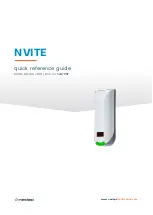
22
NOTICE
• The load chain links that are standing links on the powered
chain wheel must also be standing links on the bottom block
idler chain wheel.
3.
Ensure the load chain remains straight. Feed the chain
through the upper suspension idler chain wheel.
NOTICE
• The load chain links that are standing links on the powered
chain wheel and bottom block chain wheel must be flat links
on the upper suspension chain wheel.
4.
Ensure the load chain remains straight. Feed the load chain
through the second bottom block idler chain wheel. Insert
end link into upper suspension load end chain anchor. Do
not twist the load chain when attaching it to the load end
chain anchor. If necessary cut the last link from the load
chain (refer to Dwg. MHP0441) and remove it to prevent
twisting. Secure in place using anchor pin.
NOTICE
• The bottom block assembly may require adjustment to
ensure it is level with an equal number of load chain links
along the length of each load bearing fall. To level out the
bottom block assembly feed the load chain through the
bottom block and upper suspension idler chain wheels as
necessary to ‘balance’ the bottom block assembly. Ensure the
powered chain wheel does not turn during adjustment.
5.
Lubricate the load chain as described in the
“LUBRICATION” section. Operate the hoist fully in both
directions without a load attached. Hoist must operate
smoothly without sticking, binding or chain ‘jumping’. Test
hoist completely as described in the ‘Testing’ section
before returning to general service.
Chain Replacement
The following instructions describe the replacement of load
chain on hoists with chain installed. If the load chain has been
removed, it must be reinstalled or replaced as described in the
‘Initial Chain Installation’ section. When directed to remove or
install hoist sections or subassemblies to assist in chain
installation, refer to the applicable ‘Disassembly’ or ‘Assembly’
section for specific requirements.
CAUTION
• Damaged load chain may cause chain wheel wear or
damage and result in hoist failure, injury or property
damage. Worn or damaged load chain must be removed, the
hoist and bottom block assemblies disassembled and the
powered and idler chain wheels inspected before continuing
hoist operations.
• Do not attempt to replace load chain with hoist supporting
a load. Remove all loads.
• The following procedures use powered hoist operations.
Extreme care must be taken to ensure safe operating
conditions exist to prevent injury and hoist or property
damage when operating hoist.
Load chain replacement for all hoist models can be
accomplished efficiently and easily by using the existing load
chain to install the new load chain.
1.
Raise the hoist hook (HL1000K, HL1000KR, HL1500K) or
hook block (HL2000K, HL3000K, HL4500K, HL6000K)
to a position near the hoist where it can be properly
supported and restrained from movement.
2.
Disconnect the load chain load end link from either the
hook (HL1000K, HL1000KR, HL1500K) or the load end
chain anchor (HL2000K, HL3000K, HL4500K,
HL6000K). On the HL2000K and HL3000K, remove the
load chain from the bottom block.
3.
Using an abrasive wheel, cut a section from the end link to
form a ‘C’ link, as shown in Dwg. MHP0502.
CAUTION
• Do not distort the link in any manner. It must be able to
pass over the chain wheel(s) without binding.
4.
Connect the new chain to the old chain by inserting the end
of the new chain onto the ‘C’ link. Make certain the welds
and links on the new chain match the positioning of the
welds and links on the chain being replaced.
5.
The following hoist specific instructions describe the steps
that must be taken to complete the load chain replacement
on your hoist.
HL1000K, HL1000KR and HL1500K Chain Replacement
Complete the initial steps described in ‘Chain Replacement’.
Conduct the following additional steps on single fall hoists to
complete load chain replacement installation.
1.
Slowly operate the hoist in the raise direction to run off the
old chain and reeve the new chain over the chain wheel.
Refer to Dwg. TPA706-4.
NOTICE
• The first link of new chain over the powered chain wheel
must be a standing link.
2.
After the new chain has been reeved over the powered
chain wheel, remove the old chain and the ‘C’ link. Secure
the dead end of the load chain to the dead end chain anchor
located on the hoist. Refer to Dwg. TPA706-3. Make
certain the load chain is not twisted between the chain
wheel and dead end chain anchor.
3.
Lubricate the load chain. Refer to “LUBRICATION”
section.
4.
Rotate the last link in the load chain such that it is
perpendicular to the next link with the weld facing down,
towards the hook. Refer to parts Dwg. MHP1105. Attach
the hook to the load end of the load chain. Operate the hoist
slowly in both directions. Hoist must operate smoothly,
without sticking or binding.
HL2000K and HL3000K Chain Replacement
Complete the initial steps described in ‘Chain Replacement’.
Conduct the following additional steps on double fall hoists to
complete load chain replacement installation.
1.
Slowly operate the hoist in the raise direction to run off the
old chain and reeve the new chain over the chain wheel.
Refer to Dwg. TPA706-4.
Содержание HL1000K
Страница 33: ...33 HOIST PARTS SECTION GUIDE ...
Страница 34: ...34 HOIST HOUSING ASSEMBLY PARTS DRAWING ...
Страница 36: ...36 HOIST VALVE CHEST ASSEMBLY PARTS DRAWING ...
Страница 38: ...38 HOIST GEARING ASSEMBLY PARTS DRAWING ...
Страница 40: ...40 HOIST BRAKE ASSEMBLY PARTS DRAWING ...
Страница 44: ...44 HL1000K HL1000KR AND HL1500K HOOK ASSEMBLY PARTS DRAWING ...
Страница 46: ...46 HL2000K AND HL3000K HOOK ASSEMBLY PARTS DRAWING ...
Страница 48: ...48 HL4500K HOOK ASSEMBLY PARTS DRAWING ...
Страница 50: ...50 HL6000K HOOK ASSEMBLY PARTS DRAWING ...
Страница 52: ...52 PENDANT ASSEMBLY PARTS DRAWING ...
Страница 54: ...54 FABRIC CHAIN CONTAINER ASSEMBLY PARTS DRAWING ...
Страница 56: ...56 METAL CHAIN CONTAINER ASSEMBLY PARTS DRAWING ...
















































